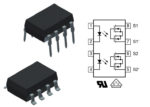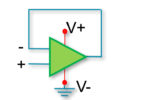An optocoupler (or optoisolator) is a device that galvanically separates circuits and is not only great at isolation but allows you to interface to circuits with different ground planes or that operate at different voltage levels. Optocouplers are “fail safe” in that if subjected to voltages higher than the maximum rating, they are known to […]
Basics of bandpass filters
Filters will allow some signals to pass through while blocking others. A bandpass (a.k.a. band-pass) filter allows signals of a certain frequency range (“a band of frequencies”) to pass through the filter as-is. (This range of accepted frequencies is called the passband. The size or range of the passband is called the bandwidth.) With a […]
Unity gain amplifier or voltage follower in a voltage divider
A voltage follower is also known as a unity gain amplifier, a voltage buffer, or an isolation amplifier. In a voltage follower circuit, the output voltage is equal to the input voltage; thus, it has a gain of one (unity) and does not amplify the incoming signal. The voltage follower does not need any external […]
Passive sensors and active sensors: What are they?
“Passives” in general within the electronics community are devices that do not drive or transmit power or signals. Passive Sensors do not control electricity directly and do not require external power sources to accomplish control of an electrical signal. Examples of passive components are resistors (R), capacitors (C), inductors (L), transformers, antennas, potentiometers (variable resistors), […]
Mutual inductance & transformers: when EMF becomes EMI
Mutual inductance is superbly demonstrated in a transformer. Transformers are made up of two wire coils placed close each other such that current running in one coil can induce a voltage in the other coil without the coils touching. Power can be transferred without a metal connection with a transformer, and transformers can be […]
Phase Locked Loop: A fundamental building block in wireless technology
A phase-lock(ed) loop (PLL) is a fundamental building block in wireless, radio frequency (RF), and telecommunication technologies. PLLs use a negative feedback circuit to match the phase of the frequency of another signal. PLLs synchronize the phase of the PLL’s output to the input signal’s frequency by tweaking the output of a voltage-driven oscillator; the […]
Pulse Width Modulation (PWM): what is it and how does it work?
Digital signals have two positions: on or off, interpreted in shorthand as 1 or 0. Analog signals, on the other hand, can be on, off, half-way, two-thirds the way to on, and an infinite number of positions between 0 and 1 either approaching 1 or descending down to zero. The two are handled very differently […]
Working with op amps: tying down floating pins
Operational amplifiers are used in many configurations and with many variations on specifications, depending upon the application. However, an IC package of operational amplifiers will often come with several in a package (e.g., a “quad pack” will have four op amps). If you have leftover, unused op amps on the same chip, the unused ones […]
Electrostatic discharge and analog circuits: Preventing the undetectable disaster
Analog circuits are exposed to outside influences most often through input channels by way of op amps acting as filters, buffers, or amplifiers. Electrostatic discharge (ESD) results from the direct contact of two things that are at different voltage potential levels and can also be defined as a fast, high current transfer. Analog circuit exposure […]
What is a CODEC?
In the embedded hardware world, the term CODEC stands for COder/DECoder and is basically an analog-to-digital converter (ADC) and a digital-to-analog converter (DAC) in one package. A codec, whether hardware or emulated in software, converts analog audio signals into digital signals for transmission or encodes them for storage in a digital format. Later, the decoder […]










